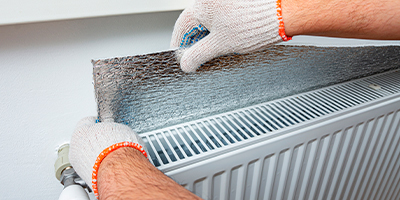Aerothermal energy
Aerothermal energy
Aerothermal energy is a system that provides cooling in the summer, heating in the winter, and domestic hot water (DHW) throughout the year.

What is thermal insulation?
An efficient measure for the home
In the last few years, the climate has been showing us that temperature and comfort are two related issues and thermal insulation plays a key role.
We are increasingly aware of the importance that thermal insulation has in our homes. Measures such as the use of insulating materials or the replacement of windows and other daily actions such as ventilation or the use of blinds can increase the quality of life at home and help to save in the energy cost.


What is thermal insulation?
Thermal insulation is the set of insulating materials and construction techniques whose installation reduces heat transmission between two spaces (between the interior and exterior of a home, or between spaces within the same home).
Knowing what thermal insulation is and what benefits it has for our home is one of the first steps to enjoy a more comfortable, environmentally-friendly home and also to reduce expenses. In this way, during winter thermal insulation can, for example, reduce heat loss, while in the summer months, it can prevent the excessive increase of heat.
The set of regulations governing the construction of buildings in Spain, known as the Technical Building Code, outlines a number of mandatory standards for the thermal insulation of buildings in its section regulating the conditions for controlling energy demand. These include the characteristics that must be met by thermal insulation materials, and the use of other elements such as blinds or awnings.
Types of thermal insulation

Broadly speaking, the types of thermal insulation in homes can be divided into two, depending on whether or not they require energy consumption: active and passive. Passive measures range from the orientation of the home or construction techniques that favor cross-ventilation to the use of thermal insulation materials in facades or floors. Active thermal insulation systems refer to the use of heating systems, cooling equipment, or humidification, among others.
In terms of types of insulation materials, polyurethane foam, expanded polystyrene, extruded polystyrene, rock wool, and glass wool are the most commonly used.
Repsol Power and Gas for the comfort of your home
By signing up to Repsol Power and Gas, as well as saving on your bills, you'll get a multitude of benefits. Discover how to do so with the Energy Plans.
Benefits of thermal insulation
Investment in the thermal insulation of the home has immediate and lasting benefits, and it is possible to recover it thanks to the financial savings it allows. These are some of them:

The kilowatt that you don't consume is the most sustainable and cheapest kilowatt, but it's true that you're still always going to have to consume something, and there you can also move towards solutions that are environmentally friendly and that help you save." In this regard, Repsol Energy Plans allow you to obtain a significant saving, while they opt for renewable energies.
Tips for improving your home's thermal insulation
"We prefer to start by keeping our homes warm: that our facades, our roofs, our windows are really protecting us from the cold. From there, we look for a heating system that is as efficient as possible, and then, above all, learn how to use our homes properly: that we know how to ventilate well, close blinds before the sun goes down to retain that heat, or seal our windows well to avoid energy leaks through them," says María Cruz Solano, an architect specializing in Energy Efficiency and Bioconstruction in the solutions area of GNE Finance, a company dedicated to the eco-sustainable rehabilitation of housing and investee company of the Repsol Foundation, in its commitment to support the growth of companies that work for the global challenge of energy transition and that generate a triple impact: economic, social, and environmental.
Aerothermal energy
Aerothermal energy is a system that provides cooling in the summer, heating in the winter, and domestic hot water (DHW) throughout the year.

What is energy saving?
The set of practices that seek to reduce energy consumption is known as energy saving and is related to the reduction of the expenditure by promoting limited energy consumption.